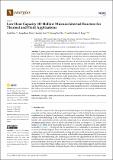Low Heat Capacity 3D Hollow Microarchitected Reactors for Thermal and Fluid Applications
Author(s)
Kim, Seok; Nam, Sang-Hoon; Kim, Seokho; Cho, Young Tae; Fang, Nicholas X.
Downloadenergies-15-04073-v2.pdf (4.833Mb)
Publisher with Creative Commons License
Publisher with Creative Commons License
Creative Commons Attribution
Terms of use
Metadata
Show full item recordAbstract
Lightweight reactor materials that simultaneously possess low heat capacity and large surface area are desirable for various applications such as catalytic supports, heat exchangers, and biological scaffolds. However, they are challenging to satisfy this criterion originating from their structural property in most porous cellular solids. Microlattices have great potential to resolve this issue in directing transport phenomena because of their hierarchically ordered design and controllable geometrical features such as porosity, specific surface, and tortuosity. In this study, we report hollow ceramic microlattices comprising a 10 μm thick hollow nickel oxide beam in an octet-truss architecture with low heat capacity and high specific surface area. Our microarchitected reactors exhibited a low heat capacity for a rapid thermal response with a small Biot number (Bi << 1) and large intertwined surface area for homogeneous flow mixing and chemical reactions, which made them ideal candidates for various energy applications. The hollow ceramic microlattice was fabricated by digital light three-dimensional (3D) printing, composite electroless plating, polymer removal, and subsequent thermal annealing. The transient thermal response and fluidic properties of the 3D-printed microstructures were experimentally investigated using a small-scale thermal and fluid test system, and analytically interpreted using simplified models. Our findings indicate that hollow microarchitected reactors provide a promising platform for developing multifunctional materials for thermal and fluid applications.
Date issued
2022-06-01Department
Massachusetts Institute of Technology. Department of Mechanical EngineeringPublisher
Multidisciplinary Digital Publishing Institute
Citation
Energies 15 (11): 4073 (2022)
Version: Final published version